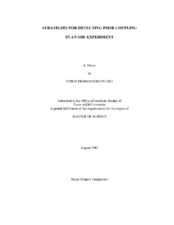| dc.description.abstract | We present a method for detecting and correcting poor coupling in an Ocean Bottom Seismic (OBS) experiment. The basic idea of our method is that the normal component (with respect to the seafloor) of particle velocity is continuous at the water-solid interface. A comparison of the normal component of particle velocity just above and below the seafloor allows us to assess poor coupling. In other words, our method for detecting poor coupling consists of analyzing vertical particle velocities measured just above and below the seafloor. The normal component of particle velocity above the water is measured using either a vertical receiver array or a vertical source array (dipole source), whereas the normal component of particle velocity below the water is directly measured in this OBS experiment.
In general, the quantities recorded in the OBS experiment are vertical and horizontal components of particle velocity, but continuity of the boundary is based on the normal component of particle velocity being oriented perpendicularly to the seafloor. For a flat seafloor, the vertical component of particle velocity values just above and below the seafloor must be almost equal according to the continuity condition at the water-solid boundary. However, for a dipping seafloor this is not the case. We have established that we can differentiate a poor coupling effect from a dipping-seafloor effect by using the vertical component of particle velocity.
We have tested our method on real (Eugene Island) data and synthetic (finite-difference) data. For finite-difference synthetics, we have used a grid spacing 0.25 meters to properly simulate the water-solid interface. By examining the uniformity (with respect to offset) of cross-correlation between the vertical component of particle velocity just above and below the seafloor, we were able to detect poor coupling and to differentiate it with any dipping effect at the seafloor. The energy of data just above and below the seafloor were also used for detecting poor coupling and for differentiating it from dipping-seafloor effect. | en |


